2023年高三高考英语外刊阅读理解训练——改编自Botany Deafened——植物也受噪音污染?(含答案)
文档属性
| 名称 | 2023年高三高考英语外刊阅读理解训练——改编自Botany Deafened——植物也受噪音污染?(含答案) | 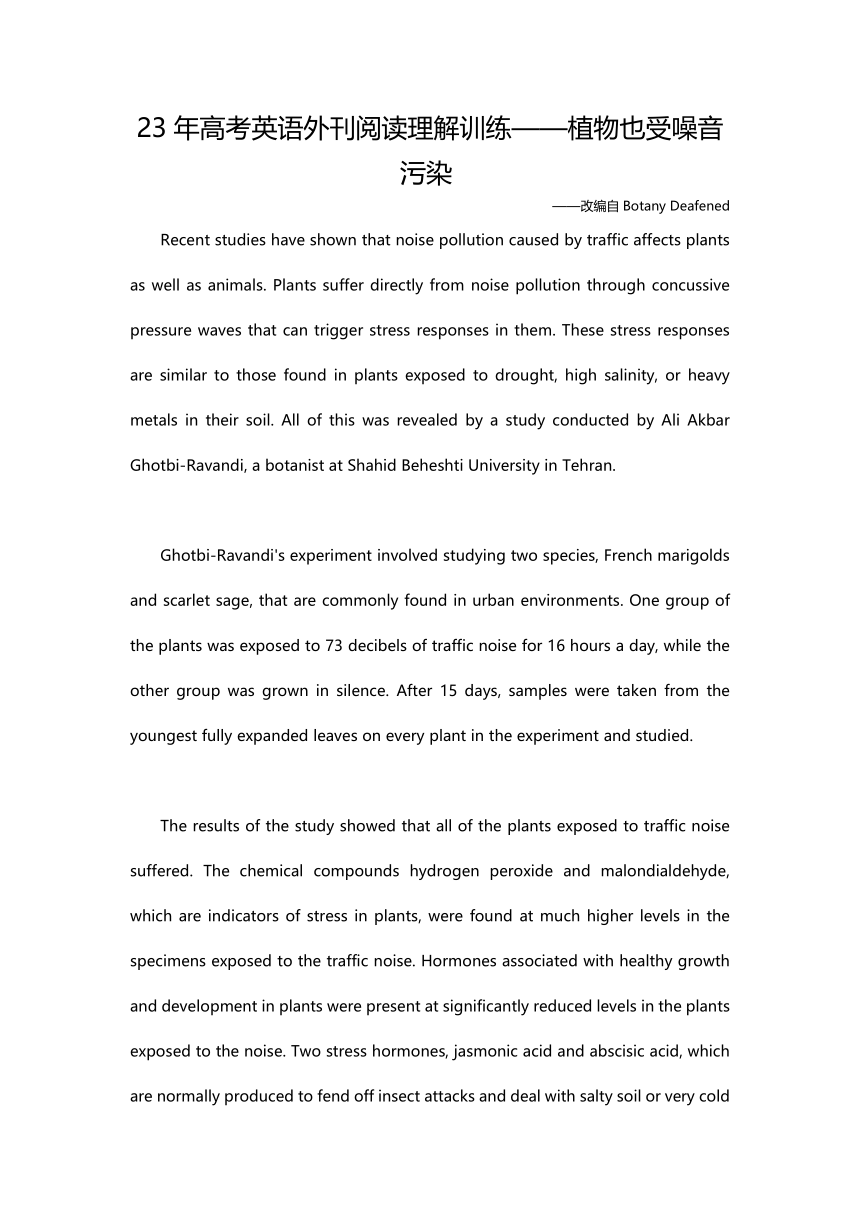 | |
| 格式 | docx | ||
| 文件大小 | 20.7KB | ||
| 资源类型 | 教案 | ||
| 版本资源 | 通用版 | ||
| 科目 | 英语 | ||
| 更新时间 | 2023-05-13 09:09:08 | ||
图片预览

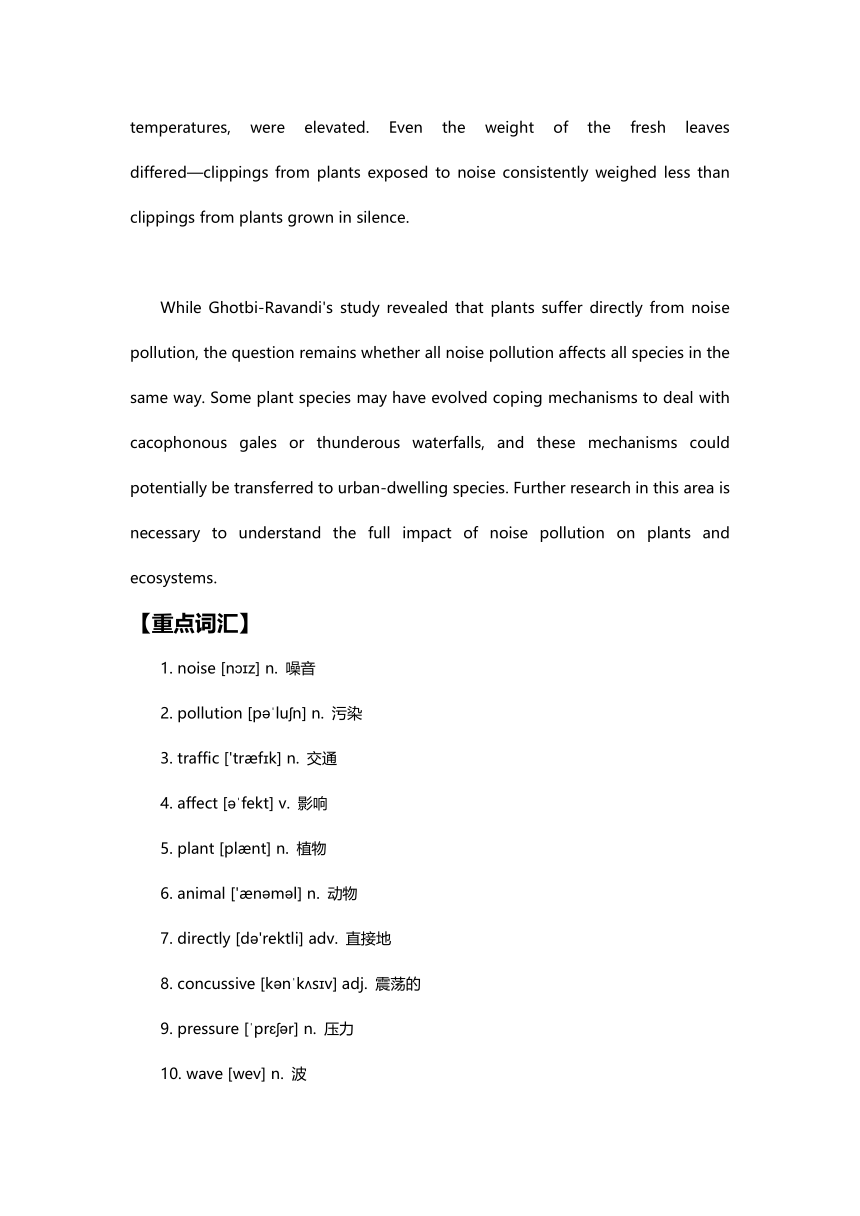
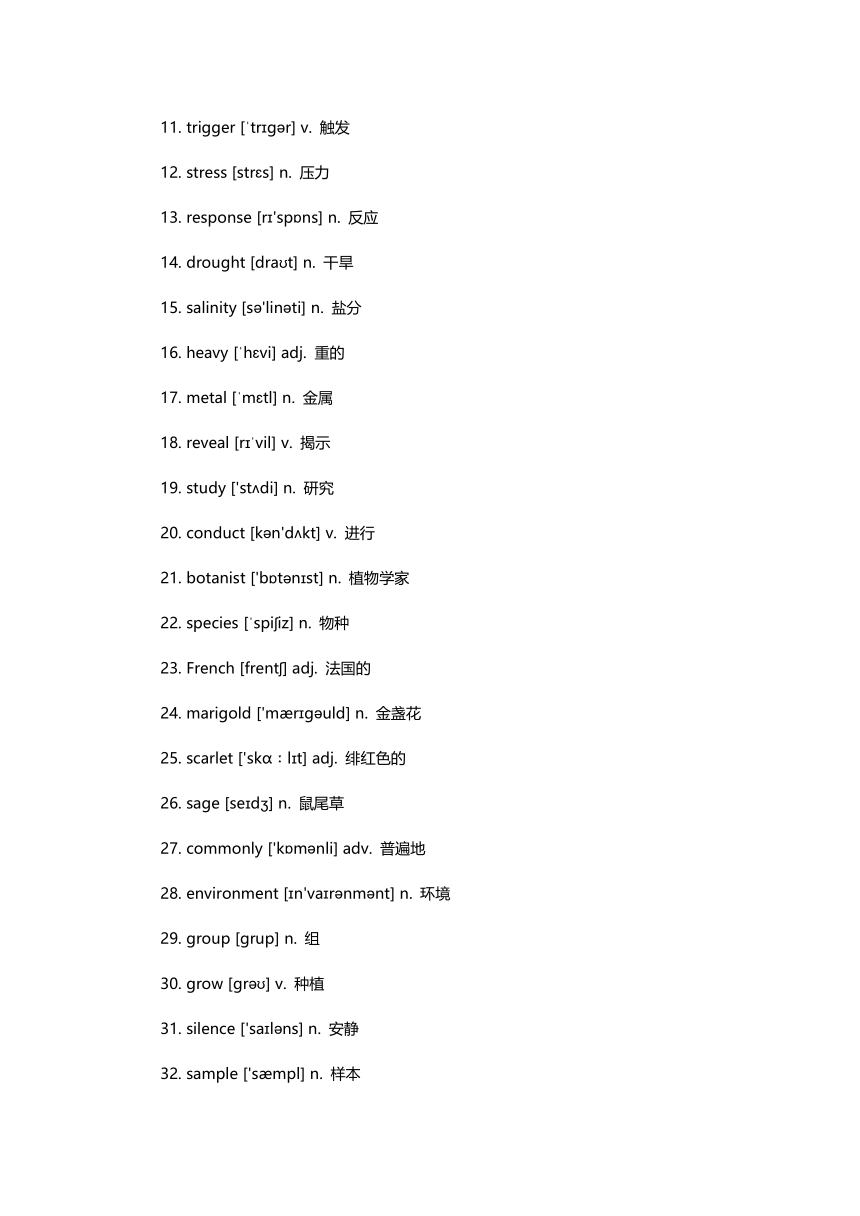
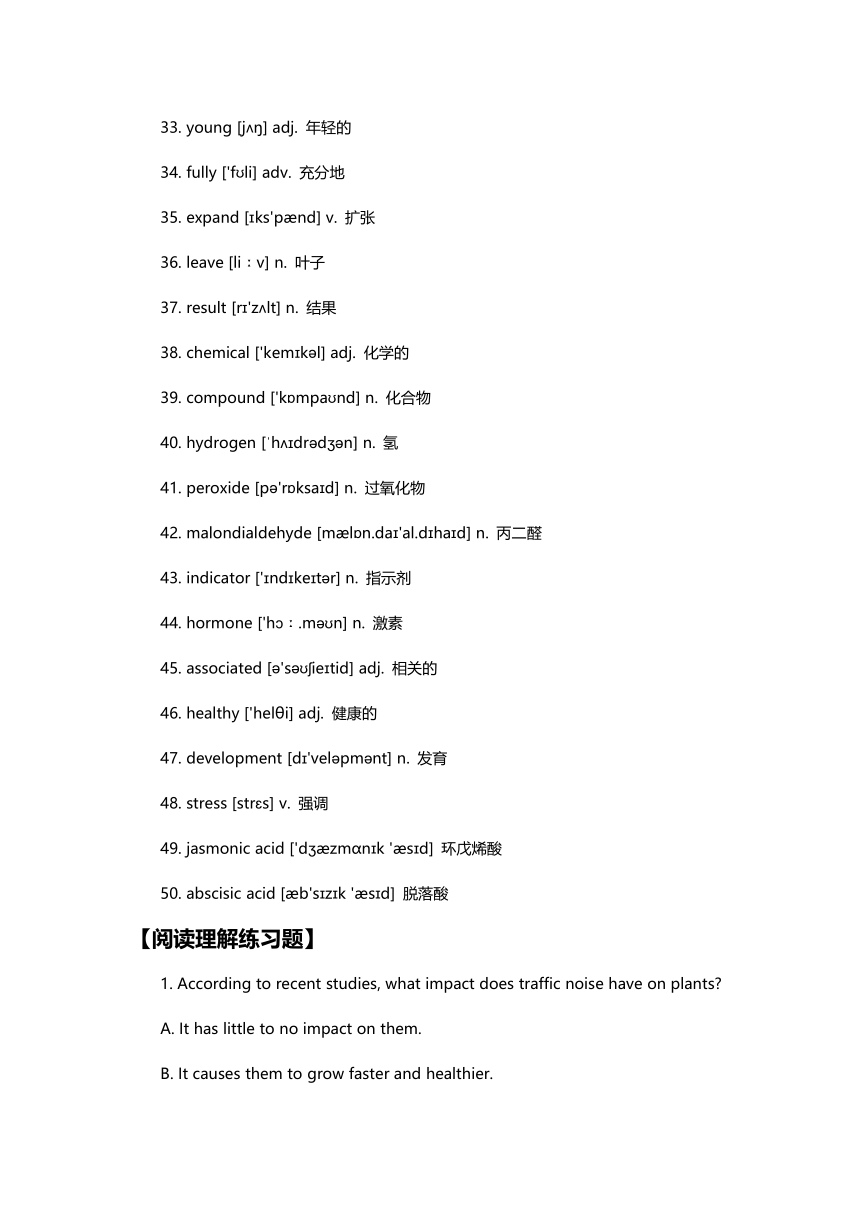
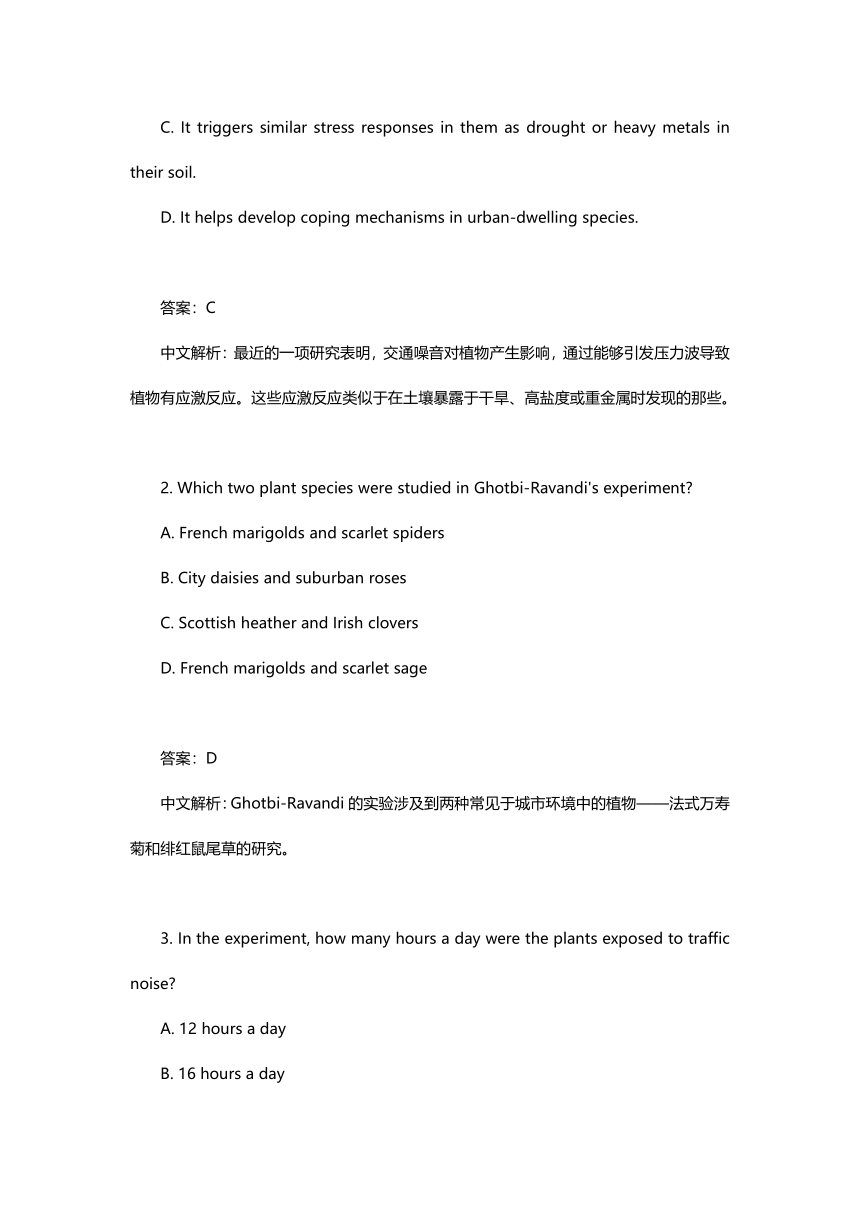
文档简介
23年高考英语外刊阅读理解训练——植物也受噪音污染
——改编自Botany Deafened
Recent studies have shown that noise pollution caused by traffic affects plants as well as animals. Plants suffer directly from noise pollution through concussive pressure waves that can trigger stress responses in them. These stress responses are similar to those found in plants exposed to drought, high salinity, or heavy metals in their soil. All of this was revealed by a study conducted by Ali Akbar Ghotbi-Ravandi, a botanist at Shahid Beheshti University in Tehran.
Ghotbi-Ravandi's experiment involved studying two species, French marigolds and scarlet sage, that are commonly found in urban environments. One group of the plants was exposed to 73 decibels of traffic noise for 16 hours a day, while the other group was grown in silence. After 15 days, samples were taken from the youngest fully expanded leaves on every plant in the experiment and studied.
The results of the study showed that all of the plants exposed to traffic noise suffered. The chemical compounds hydrogen peroxide and malondialdehyde, which are indicators of stress in plants, were found at much higher levels in the specimens exposed to the traffic noise. Hormones associated with healthy growth and development in plants were present at significantly reduced levels in the plants exposed to the noise. Two stress hormones, jasmonic acid and abscisic acid, which are normally produced to fend off insect attacks and deal with salty soil or very cold temperatures, were elevated. Even the weight of the fresh leaves differed—clippings from plants exposed to noise consistently weighed less than clippings from plants grown in silence.
While Ghotbi-Ravandi's study revealed that plants suffer directly from noise pollution, the question remains whether all noise pollution affects all species in the same way. Some plant species may have evolved coping mechanisms to deal with cacophonous gales or thunderous waterfalls, and these mechanisms could potentially be transferred to urban-dwelling species. Further research in this area is necessary to understand the full impact of noise pollution on plants and ecosystems.
【重点词汇】
1. noise [n z] n. 噪音
2. pollution [p lu n] n. 污染
3. traffic ['tr f k] n. 交通
4. affect [ fekt] v. 影响
5. plant [pl nt] n. 植物
6. animal [' n m l] n. 动物
7. directly [d 'rektli] adv. 直接地
8. concussive [k n k s v] adj. 震荡的
9. pressure [ pr r] n. 压力
10. wave [wev] n. 波
11. trigger [ tr g r] v. 触发
12. stress [str s] n. 压力
13. response [r 'sp ns] n. 反应
14. drought [dra t] n. 干旱
15. salinity [s 'lin ti] n. 盐分
16. heavy [ h vi] adj. 重的
17. metal [ m tl] n. 金属
18. reveal [r vil] v. 揭示
19. study ['st di] n. 研究
20. conduct [k n'd kt] v. 进行
21. botanist ['b t n st] n. 植物学家
22. species [ spi iz] n. 物种
23. French [frent ] adj. 法国的
24. marigold ['m r g uld] n. 金盏花
25. scarlet ['skɑ l t] adj. 绯红色的
26. sage [se d ] n. 鼠尾草
monly ['k m nli] adv. 普遍地
28. environment [ n'va r nm nt] n. 环境
29. group [grup] n. 组
30. grow [ɡr ] v. 种植
31. silence ['sa l ns] n. 安静
32. sample ['s mpl] n. 样本
33. young [j ] adj. 年轻的
34. fully ['f li] adv. 充分地
35. expand [ ks'p nd] v. 扩张
36. leave [li v] n. 叶子
37. result [r 'z lt] n. 结果
38. chemical ['kem k l] adj. 化学的
pound ['k mpa nd] n. 化合物
40. hydrogen [ h dr d n] n. 氢
41. peroxide [p 'r ksa d] n. 过氧化物
42. malondialdehyde [m l n.da 'al.d ha d] n. 丙二醛
43. indicator [' nd ke t r] n. 指示剂
44. hormone ['h .m n] n. 激素
45. associated [ 's ie tid] adj. 相关的
46. healthy ['helθi] adj. 健康的
47. development [d 'vel pm nt] n. 发育
48. stress [str s] v. 强调
49. jasmonic acid ['d zmɑn k ' s d] 环戊烯酸
50. abscisic acid [ b's z k ' s d] 脱落酸
【阅读理解练习题】
1. According to recent studies, what impact does traffic noise have on plants
A. It has little to no impact on them.
B. It causes them to grow faster and healthier.
C. It triggers similar stress responses in them as drought or heavy metals in their soil.
D. It helps develop coping mechanisms in urban-dwelling species.
答案:C
中文解析:最近的一项研究表明,交通噪音对植物产生影响,通过能够引发压力波导致植物有应激反应。这些应激反应类似于在土壤暴露于干旱、高盐度或重金属时发现的那些。
2. Which two plant species were studied in Ghotbi-Ravandi's experiment
A. French marigolds and scarlet spiders
B. City daisies and suburban roses
C. Scottish heather and Irish clovers
D. French marigolds and scarlet sage
答案:D
中文解析:Ghotbi-Ravandi的实验涉及到两种常见于城市环境中的植物——法式万寿菊和绯红鼠尾草的研究。
3. In the experiment, how many hours a day were the plants exposed to traffic noise
A. 12 hours a day
B. 16 hours a day
C. 24 hours a day
D. 48 hours a day
答案:B
中文解析:实验中,植物每天接触到73分贝的交通噪音长达16个小时。
4. What two chemical compounds were found at higher levels in plants exposed to traffic noise
A. Calcium and potassium
B. Hydrogen peroxide and malondialdehyde
C. Iron and zinc
D. Nitrogen and oxygen
答案:B
中文解析:实验表明受到交通噪声污染的植物中发现了氢过氧化物和丙二醛这两种化学物质,这些是植物应激反应的指标,高于未受到交通噪声影响的植物。
5. According to the article, what impact did traffic noise have on hormones associated with healthy growth and development in plants
A. They had no effect.
B. They increased significantly.
C. They decreased significantly.
D. They varied unpredictably.
答案:C
中文解析:研究发现,服务于植物健康生长和发育的激素在受到交通噪声的影响下,数量显著降低。
6. What can be inferred about the weight of fresh leaves from plants grown in silence as compared to those exposed to traffic noise
A. They were consistently heavier.
B. They were consistently lighter.
C. There was no significant difference.
D. They varied unpredictably.
答案:B
中文解析:即使新鲜叶子的重量也有所不同——暴露在噪音中的植物的剪辑重量始终比安静生长的植物的剪辑重量轻。
7. Why do the researchers suggest further research is needed in this area
A. To prove that plants are not affected by noise pollution.
B. To determine which plant species are most affected by traffic noise.
C. To understand whether all noise pollution affects all species in the same way.
D. To develop new noise-coping mechanisms for urban-dwelling species.
答案:C
中文解析:作者提出研究还需要深入,以了解噪声污染对植物和生态系统的完整影响,其中一个问题是是否所有噪声污染都会以相同方式影响所有物种。
8. What can be concluded from the article about the potential for noise-coping mechanisms to be transferred to urban-dwelling species
A. It is highly unlikely due to evolutionary differences.
B. It is likely, but more research is needed to confirm it.
C. It is impossible due to fundamental biological differences.
D. It has already been proven by previous studies.
答案:B
中文解析:虽然植物也许已经进化出适应嘈杂环境的机制,但需要更多的研究来证明,并理解噪音污染对植物和生态系统的完整影响。
【全文逐句对照翻译】
最近的研究表明,交通造成的噪音污染不仅影响动物,也影响植物。
Recent studies have shown that noise pollution caused by traffic affects plants as well as animals.
植物通过震荡压力波直接遭受噪音污染,这些压力波会引发植物的应激反应。
Plants suffer directly from noise pollution through concussive pressure waves that can trigger stress responses in them.
这些应激反应与植物暴露于干旱、高盐度或土壤重金属中的情况相似。
These stress responses are similar to those found in plants exposed to drought, high salinity, or heavy metals in their soil.
所有这些都是由德黑兰沙希德·贝赫什蒂大学的植物学家阿里·阿克巴尔·戈特比·拉万迪进行的一项研究揭示的。
All of this was revealed by a study conducted by Ali Akbar Ghotbi-Ravandi, a botanist at Shahid Beheshti University in Tehran.
Ghotbi-Ravandi的实验研究了两种常见于城市环境的植物,法国万寿菊和鲜红鼠尾草。
Ghotbi-Ravandi's experiment involved studying two species, French marigolds and scarlet sage, that are commonly found in urban environments.
其中一组植物每天16小时暴露在73分贝的交通噪音中,而另一组则在安静的环境中生长。
One group of the plants was exposed to 73 decibels of traffic noise for 16 hours a day, while the other group was grown in silence.
15天后,从实验中每棵植物最年轻的完全展开的叶子上采集样本进行研究。
After 15 days, samples were taken from the youngest fully expanded leaves on every plant in the experiment and studied.
研究结果表明,所有暴露在交通噪音下的植物都受到了影响。
The results of the study showed that all of the plants exposed to traffic noise suffered.
过氧化氢和丙二醛这两种化合物是植物的应激指标,在暴露于交通噪音的样本中含量要高得多。
The chemical compounds hydrogen peroxide and malondialdehyde, which are indicators of stress in plants, were found at much higher levels in the specimens exposed to the traffic noise.
与植物健康生长发育相关的激素水平在暴露于噪音的植物中显著降低。
Hormones associated with healthy growth and development in plants were present at significantly reduced levels in the plants exposed to the noise.
两种应激激素,茉莉酸和脱落酸,通常是为了抵御昆虫袭击和应对盐碱地或极冷的温度而产生的。
Two stress hormones, jasmonic acid and abscisic acid, which are normally produced to fend off insect attacks and deal with salty soil or very cold temperatures, were elevated.
即使是新鲜叶子的重量也有所不同——在噪音中生长的植物的剪枝总是比在安静中生长的植物的剪枝轻。
Even the weight of the fresh leaves differed—clippings from plants exposed to noise consistently weighed less than clippings from plants grown in silence.
虽然Ghotbi-Ravandi的研究表明植物直接遭受噪音污染,但问题仍然是所有噪音污染是否以同样的方式影响所有物种。
While Ghotbi-Ravandi's study revealed that plants suffer directly from noise pollution, the question remains whether all noise pollution affects all species in the same way.
一些植物物种可能已经进化出了应对机制来应对嘈杂的大风或雷鸣般的瀑布,这些机制可能会转移到城市生活的物种身上。
Some plant species may have evolved coping mechanisms to deal with cacophonous gales or thunderous waterfalls, and these mechanisms could potentially be transferred to urban-dwelling species.
为了全面了解噪声污染对植物和生态系统的影响,有必要在这一领域进行进一步的研究。
Further research in this area is necessary to understand the full impact of noise pollution on plants and ecosystems.
——改编自Botany Deafened
Recent studies have shown that noise pollution caused by traffic affects plants as well as animals. Plants suffer directly from noise pollution through concussive pressure waves that can trigger stress responses in them. These stress responses are similar to those found in plants exposed to drought, high salinity, or heavy metals in their soil. All of this was revealed by a study conducted by Ali Akbar Ghotbi-Ravandi, a botanist at Shahid Beheshti University in Tehran.
Ghotbi-Ravandi's experiment involved studying two species, French marigolds and scarlet sage, that are commonly found in urban environments. One group of the plants was exposed to 73 decibels of traffic noise for 16 hours a day, while the other group was grown in silence. After 15 days, samples were taken from the youngest fully expanded leaves on every plant in the experiment and studied.
The results of the study showed that all of the plants exposed to traffic noise suffered. The chemical compounds hydrogen peroxide and malondialdehyde, which are indicators of stress in plants, were found at much higher levels in the specimens exposed to the traffic noise. Hormones associated with healthy growth and development in plants were present at significantly reduced levels in the plants exposed to the noise. Two stress hormones, jasmonic acid and abscisic acid, which are normally produced to fend off insect attacks and deal with salty soil or very cold temperatures, were elevated. Even the weight of the fresh leaves differed—clippings from plants exposed to noise consistently weighed less than clippings from plants grown in silence.
While Ghotbi-Ravandi's study revealed that plants suffer directly from noise pollution, the question remains whether all noise pollution affects all species in the same way. Some plant species may have evolved coping mechanisms to deal with cacophonous gales or thunderous waterfalls, and these mechanisms could potentially be transferred to urban-dwelling species. Further research in this area is necessary to understand the full impact of noise pollution on plants and ecosystems.
【重点词汇】
1. noise [n z] n. 噪音
2. pollution [p lu n] n. 污染
3. traffic ['tr f k] n. 交通
4. affect [ fekt] v. 影响
5. plant [pl nt] n. 植物
6. animal [' n m l] n. 动物
7. directly [d 'rektli] adv. 直接地
8. concussive [k n k s v] adj. 震荡的
9. pressure [ pr r] n. 压力
10. wave [wev] n. 波
11. trigger [ tr g r] v. 触发
12. stress [str s] n. 压力
13. response [r 'sp ns] n. 反应
14. drought [dra t] n. 干旱
15. salinity [s 'lin ti] n. 盐分
16. heavy [ h vi] adj. 重的
17. metal [ m tl] n. 金属
18. reveal [r vil] v. 揭示
19. study ['st di] n. 研究
20. conduct [k n'd kt] v. 进行
21. botanist ['b t n st] n. 植物学家
22. species [ spi iz] n. 物种
23. French [frent ] adj. 法国的
24. marigold ['m r g uld] n. 金盏花
25. scarlet ['skɑ l t] adj. 绯红色的
26. sage [se d ] n. 鼠尾草
monly ['k m nli] adv. 普遍地
28. environment [ n'va r nm nt] n. 环境
29. group [grup] n. 组
30. grow [ɡr ] v. 种植
31. silence ['sa l ns] n. 安静
32. sample ['s mpl] n. 样本
33. young [j ] adj. 年轻的
34. fully ['f li] adv. 充分地
35. expand [ ks'p nd] v. 扩张
36. leave [li v] n. 叶子
37. result [r 'z lt] n. 结果
38. chemical ['kem k l] adj. 化学的
pound ['k mpa nd] n. 化合物
40. hydrogen [ h dr d n] n. 氢
41. peroxide [p 'r ksa d] n. 过氧化物
42. malondialdehyde [m l n.da 'al.d ha d] n. 丙二醛
43. indicator [' nd ke t r] n. 指示剂
44. hormone ['h .m n] n. 激素
45. associated [ 's ie tid] adj. 相关的
46. healthy ['helθi] adj. 健康的
47. development [d 'vel pm nt] n. 发育
48. stress [str s] v. 强调
49. jasmonic acid ['d zmɑn k ' s d] 环戊烯酸
50. abscisic acid [ b's z k ' s d] 脱落酸
【阅读理解练习题】
1. According to recent studies, what impact does traffic noise have on plants
A. It has little to no impact on them.
B. It causes them to grow faster and healthier.
C. It triggers similar stress responses in them as drought or heavy metals in their soil.
D. It helps develop coping mechanisms in urban-dwelling species.
答案:C
中文解析:最近的一项研究表明,交通噪音对植物产生影响,通过能够引发压力波导致植物有应激反应。这些应激反应类似于在土壤暴露于干旱、高盐度或重金属时发现的那些。
2. Which two plant species were studied in Ghotbi-Ravandi's experiment
A. French marigolds and scarlet spiders
B. City daisies and suburban roses
C. Scottish heather and Irish clovers
D. French marigolds and scarlet sage
答案:D
中文解析:Ghotbi-Ravandi的实验涉及到两种常见于城市环境中的植物——法式万寿菊和绯红鼠尾草的研究。
3. In the experiment, how many hours a day were the plants exposed to traffic noise
A. 12 hours a day
B. 16 hours a day
C. 24 hours a day
D. 48 hours a day
答案:B
中文解析:实验中,植物每天接触到73分贝的交通噪音长达16个小时。
4. What two chemical compounds were found at higher levels in plants exposed to traffic noise
A. Calcium and potassium
B. Hydrogen peroxide and malondialdehyde
C. Iron and zinc
D. Nitrogen and oxygen
答案:B
中文解析:实验表明受到交通噪声污染的植物中发现了氢过氧化物和丙二醛这两种化学物质,这些是植物应激反应的指标,高于未受到交通噪声影响的植物。
5. According to the article, what impact did traffic noise have on hormones associated with healthy growth and development in plants
A. They had no effect.
B. They increased significantly.
C. They decreased significantly.
D. They varied unpredictably.
答案:C
中文解析:研究发现,服务于植物健康生长和发育的激素在受到交通噪声的影响下,数量显著降低。
6. What can be inferred about the weight of fresh leaves from plants grown in silence as compared to those exposed to traffic noise
A. They were consistently heavier.
B. They were consistently lighter.
C. There was no significant difference.
D. They varied unpredictably.
答案:B
中文解析:即使新鲜叶子的重量也有所不同——暴露在噪音中的植物的剪辑重量始终比安静生长的植物的剪辑重量轻。
7. Why do the researchers suggest further research is needed in this area
A. To prove that plants are not affected by noise pollution.
B. To determine which plant species are most affected by traffic noise.
C. To understand whether all noise pollution affects all species in the same way.
D. To develop new noise-coping mechanisms for urban-dwelling species.
答案:C
中文解析:作者提出研究还需要深入,以了解噪声污染对植物和生态系统的完整影响,其中一个问题是是否所有噪声污染都会以相同方式影响所有物种。
8. What can be concluded from the article about the potential for noise-coping mechanisms to be transferred to urban-dwelling species
A. It is highly unlikely due to evolutionary differences.
B. It is likely, but more research is needed to confirm it.
C. It is impossible due to fundamental biological differences.
D. It has already been proven by previous studies.
答案:B
中文解析:虽然植物也许已经进化出适应嘈杂环境的机制,但需要更多的研究来证明,并理解噪音污染对植物和生态系统的完整影响。
【全文逐句对照翻译】
最近的研究表明,交通造成的噪音污染不仅影响动物,也影响植物。
Recent studies have shown that noise pollution caused by traffic affects plants as well as animals.
植物通过震荡压力波直接遭受噪音污染,这些压力波会引发植物的应激反应。
Plants suffer directly from noise pollution through concussive pressure waves that can trigger stress responses in them.
这些应激反应与植物暴露于干旱、高盐度或土壤重金属中的情况相似。
These stress responses are similar to those found in plants exposed to drought, high salinity, or heavy metals in their soil.
所有这些都是由德黑兰沙希德·贝赫什蒂大学的植物学家阿里·阿克巴尔·戈特比·拉万迪进行的一项研究揭示的。
All of this was revealed by a study conducted by Ali Akbar Ghotbi-Ravandi, a botanist at Shahid Beheshti University in Tehran.
Ghotbi-Ravandi的实验研究了两种常见于城市环境的植物,法国万寿菊和鲜红鼠尾草。
Ghotbi-Ravandi's experiment involved studying two species, French marigolds and scarlet sage, that are commonly found in urban environments.
其中一组植物每天16小时暴露在73分贝的交通噪音中,而另一组则在安静的环境中生长。
One group of the plants was exposed to 73 decibels of traffic noise for 16 hours a day, while the other group was grown in silence.
15天后,从实验中每棵植物最年轻的完全展开的叶子上采集样本进行研究。
After 15 days, samples were taken from the youngest fully expanded leaves on every plant in the experiment and studied.
研究结果表明,所有暴露在交通噪音下的植物都受到了影响。
The results of the study showed that all of the plants exposed to traffic noise suffered.
过氧化氢和丙二醛这两种化合物是植物的应激指标,在暴露于交通噪音的样本中含量要高得多。
The chemical compounds hydrogen peroxide and malondialdehyde, which are indicators of stress in plants, were found at much higher levels in the specimens exposed to the traffic noise.
与植物健康生长发育相关的激素水平在暴露于噪音的植物中显著降低。
Hormones associated with healthy growth and development in plants were present at significantly reduced levels in the plants exposed to the noise.
两种应激激素,茉莉酸和脱落酸,通常是为了抵御昆虫袭击和应对盐碱地或极冷的温度而产生的。
Two stress hormones, jasmonic acid and abscisic acid, which are normally produced to fend off insect attacks and deal with salty soil or very cold temperatures, were elevated.
即使是新鲜叶子的重量也有所不同——在噪音中生长的植物的剪枝总是比在安静中生长的植物的剪枝轻。
Even the weight of the fresh leaves differed—clippings from plants exposed to noise consistently weighed less than clippings from plants grown in silence.
虽然Ghotbi-Ravandi的研究表明植物直接遭受噪音污染,但问题仍然是所有噪音污染是否以同样的方式影响所有物种。
While Ghotbi-Ravandi's study revealed that plants suffer directly from noise pollution, the question remains whether all noise pollution affects all species in the same way.
一些植物物种可能已经进化出了应对机制来应对嘈杂的大风或雷鸣般的瀑布,这些机制可能会转移到城市生活的物种身上。
Some plant species may have evolved coping mechanisms to deal with cacophonous gales or thunderous waterfalls, and these mechanisms could potentially be transferred to urban-dwelling species.
为了全面了解噪声污染对植物和生态系统的影响,有必要在这一领域进行进一步的研究。
Further research in this area is necessary to understand the full impact of noise pollution on plants and ecosystems.
